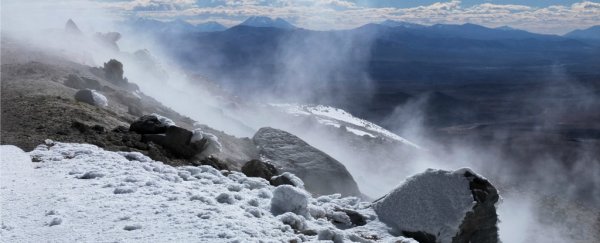Scientists have discovered an unexpected reservoir of water comparable in volume to Lake Superior, hidden 15 km (9.3 miles) below a volcano in the Andes.
The team thinks there could be more of these strange lakes lurking beneath other major volcanoes around the planet - and they could help solve the ongoing mystery of how and why volcanoes erupt.
The giant body of water was discovered when a team of researchers led by the University of Bristol in the UK investigated an 'anomaly' they'd spotted below the currently dormant Uturuncu volcano in the Bolivian andes.
Upon closer examination, they found something surprising - a body of water with a volume of roughly 1.5 million cubic kilometres - comparable to the volume of Lake Superior, the largest of the great lakes in North America.
"It's probably somewhere between Lake Superior and Lake Huron," lead researcher Jon Blundy told Andy Coghlan at New Scientist. "It's a staggeringly large amount."
But unlike freshwater lakes on the surface, the reservoir, which has been named the Altiplano-Puna magma body, has a temperature of almost 1,000 degrees Celsius, and is mixed in with molten rock. And it might have the potential to make a volcano more explosive.
Importantly, the Altiplano-Puna magma body seems to slow down seismic waves and conduct electricity, unlike the surrounding magma that's not mixed in with water.
To try to figure out how this works, the team took 500,000-year-old rocks blasted out by the volcano, and mixed them with water in the lab under the same conditions as 15 km below the surface.
They calculated that there must be around 8 to 10 percent of water dissolved in the silicate melt - which explains the type of electrical conductivity they'd spotted in the anomaly.
"Ten percent by weight of dissolved water means that there is one molecule of water for every three molecules of silicate," one of the researchers, Fabrice Gaillard from the University of Orléans in France, said in a press release.
"This is an extraordinarily large fraction of water, helping to explain why these silicate liquids are so electrically conductive."
The team still doesn't know why that electrical conductivity is so important, or how it influences eruptions, but they've spotted similar unexplained conductivity below the Taupo Volcanic Zone in New Zealand, and the US's deadliest volcano, Mount St Helens in Washington State.
The researchers now plan to investigate whether this strange conductivity is also evidence of secret water reservoirs deep below the surface of these other major volcanoes - and, if so, they'll hopefully be able to figure out how they drive eruptions.
This might even help them predict us better in the future.
Importantly, the research also sheds light on the complex process of how water deep below Earth's surface interacts and influences the formation of Earth's crust - something we're only just beginning to understand.
"This study illuminates a new feature of Earth's deep-water cycle, and reminds us how little we know about the pathway of water through Earth's crust and mantle systems on geologic timescales," Steve Jacobsen from Northwestern University in Evanston, Illinois, who wasn't involved in the study, told New Scientist.
We still have a lot to learn, but we can't wait to see what else Earth is hiding beneath its surface.
The research has been published in Earth and Planetary Science Letters.
